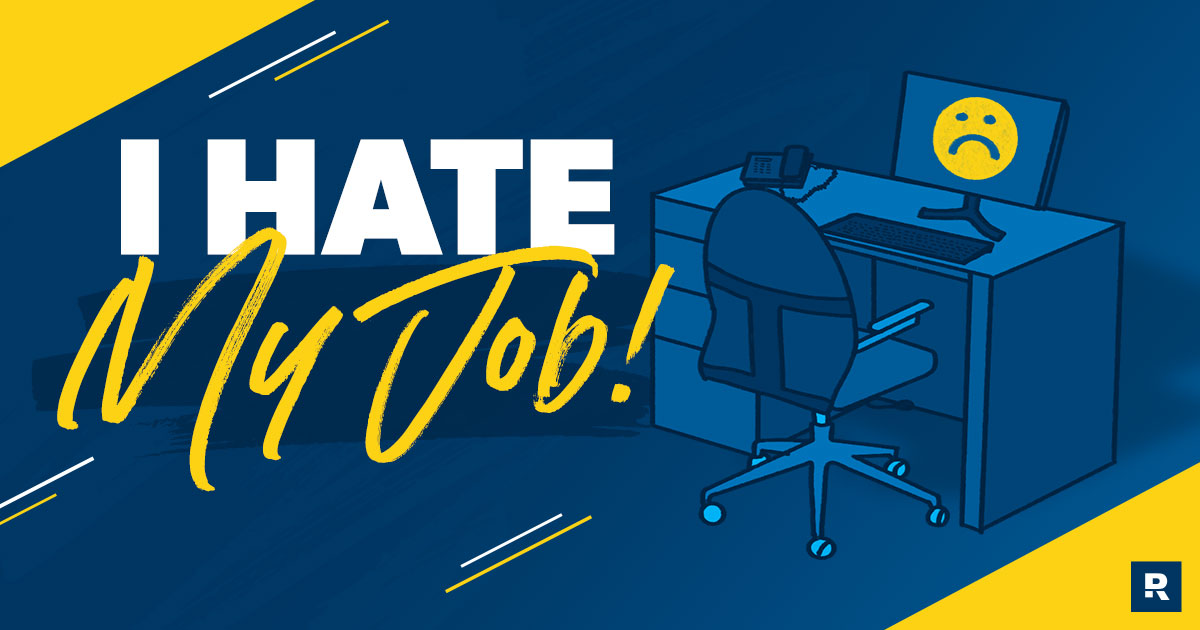
Key Takeaways
- You don’t have to be stuck in a job you hate forever—but there’s a right way to move toward more meaningful work.
- Focusing on the positive parts of your job (like the valuable skills, stability and connections) helps you focus and prepares you for what’s next.
- Clarifying your strengths, passions and mission will help you identify the kind of job you’ll actually love.
- Make connections in your desired role/industry, update your resumé, and make sure your finances are in order before you decide to quit the current job.
“I hate my job. What do I do?”
Get expert money advice to reach your money goals faster!
It doesn’t matter how many times I hear that—it’s heartbreaking every single time.
The unfortunate reality is, 12% of Americans aren’t satisfied with their current work situation.1 Now that might not seem like much, but keep in mind that 12% of the American workforce is almost 20 million people!2 That’s a lot of folks who are desperately searching for answers. But there’s hope . . . and a way forward.
You don’t have to stay where you are forever or spend the rest of your life feeling miserable at work. So, if this is you—if you hate your job and want to quit—I want to walk you through the right way to find a new career you actually love.
9 Tips When You Hate Your Job
When you hate your job, every day can seem like a never-ending drag. There are lots of valid reasons for leaving a job. Maybe it’s a well-meaning but micromanaging leader. Or the work environment is hostile. Or maybe your boss is just a jerk.
But there are ways to shift your perspective and find the silver lining—and maybe even see that your current role isn’t so bad after all. Let’s explore these nine tips for when you hate your job:
1. Change your focus.
2. Concentrate on the skills you’re building.
3. Be grateful for your stability—while looking for the next opportunity.
4. Focus on your future.
5. Get your finances in order.
6. Brainstorm your dream job.
7. Start making connections.
8. Decide if you should quit.
9. Update your resumé.
1. Change your focus.
Did you know your brain searches for evidence to support your thoughts? If you’re constantly focusing on the negative aspects of your current job, your brain is going to continually look for evidence to support that negative view.
On the flip side, if you start to focus on the positive aspects of your job (we’ll talk about a few of them in the tips below), you’ll notice more of the good in your workplace. When we change what we focus on, we change how we act and feel. It’s not the other way around.
So, if the truth is that what you focus on intensifies, what good can you start focusing on in the job you hate?
2. Concentrate on the skills you’re building.
You may hate your job today, but think about this: What are you learning there? What experience are you gaining that you can add to your resumé? What connections and friendships are you making that can lead to an open door somewhere else?
If you have the mindset of a lifelong learner, then you’ll look for ways to learn and grow everywhere you go. That means, no matter how related or unrelated your current job is to your dream job, you’ll find something in your current job to take with you to the next one.
At the end of the day, no matter where you’re working, you only get out what you put in. When you change your mindset to a positive outlook, you’ll be better able to build an exit plan that doesn’t burn any bridges.
3. Be grateful for your stability—while looking for the next opportunity.
The last thing you need when you’re trying to step into your dream job is to lie awake at night worried about how you’re going to eat or pay rent. When you’re worried about finances, you’ll settle for a mediocre job instead of taking your time to land the next right job.
That’s why I want to encourage you to focus on the stability your current job provides you. You haven’t been laid off. You have a regular paycheck coming in, and that stability means you can take your time to find the best opportunity.
4. Focus on your future.
The stability you get from your current job doesn’t just buy you time to find the right opportunity—it can also buy you the time to build the experience you need to get your next job.
Use this time to start a side hustle, take a class in the evenings, shadow someone on the weekends, or take industry connections out to coffee. Building the experience, skills and connections to land a great job takes time, perseverance and patience. And when you have a job and a regular income keeping you afloat, you can allow for that.
5. Get your finances in order.
Remember, your current job is providing stability and buying you time. Use that financial security to stack up some savings. Having a financial safety net means you can make career decisions based on what you truly want, not what you need to get by.
I recommend having 3–6 months of living expenses in the bank before you quit your job—especially if you’re quitting before you have another job lined up. But even if you do have another job lined up, it’s still a good idea to have an emergency fund in place, just in case things at the new job don’t turn out as expected.
Get Clear Career Assessment for Career Change
6. Brainstorm your dream job.
While you’re stacking up those savings, start clarifying and verifying your sweet spot. Your sweet spot is what I call the place where what you do best, what you love to do most, and the results that matter most to you intersect.
You can clarify and verify your sweet spot by making a list of your:
- Talents: skills and strengths that you actually enjoy using
- Passions: activities that make you feel alive and give you energy
- Mission: who you most want to help and what problem you most what to solve
Look over the list and see if any themes pop up. How can you combine your talents, passions and mission in a professional setting? Do some research to find potential jobs that have a healthy mix.
Take your time with this and include people you love and trust into the conversation so they can provide feedback. These people can not only help point out talents and passions that you may not even realize you have, but they can also help you brainstorm industries and jobs that fit within your sweet spot.
If you need help nailing down your talents, passions and mission, try my free Career Clarity Guide. It's a worksheet designed to help nail down your sweet spot so you can take bold steps toward your dream job.
7. Start making connections.
Once you’ve clarified what industry and position you want to go after, you can start practicing the tried and true Proximity Principle. I break this principle down in my bestselling book The Proximity Principle: The Proven Strategy That Will Lead to the Career You Love.
The Proximity Principle says that to do what you want to do, you have to be around people who are doing it and be in the places it’s happening. Get around the right people, in the right places, and it will change your life for the better.
Some of the people you can look to for help are professors, professionals, mentors, peers and producers (people building businesses or leading others)—and they’re everywhere. You don’t have to go far to meet them because they’re in your city, workplace, neighborhood, church and more. You just have to keep your eyes peeled.
Create your web of connections in every place you encounter, be intentional about building relationships with the people you meet along the way, and seize every opportunity to get one step closer to your dream job.
It’s time to stop wasting your time dwelling on how much you hate your job. Instead, use that time and energy to do whatever it takes to move into a career you love. There is a way out for you.
8. Decide if you should quit.
You might be working at the right company in the wrong role. Or you’re in the right role at the wrong company. You could also be in the wrong role at the wrong company. In any case, you have the option to stay or go. To help you understand if and when it’s time to quit, my team and I have developed a free tool: the Should I Quit my Job Quiz. It will offer some clarity before you make this big decision.
9. Update your resumé.
If you’ve decided it’s time to quit and move on to your next opportunity, there’s one important thing you need to do before you start job hunting: You’ve got to update your resumé! Make sure you include experience you’ve gained in your current role. If you need help putting it all together, check out my resumé templates.
Take the Next Step Toward Your Dream Job
Above all, here's what I want you to remember: Hating your job is a temporary situation. You don't have to stay in a soul-sucking job forever. Now, fear and doubt may creep in and start telling you lies like, "Quitting your job is too risky," or, "Your next job won't be any better than this one." But, my friends, those are plain lies.
You can make a plan to safely leave your current job and find a new one. You can end up in a job you love. And you can kiss the Sunday Scaries goodbye once and for all. I know you have what it takes to start working toward a better, more fulfilling job.
Sure, it’ll take self-reflection and intentionality to start building skills and meeting people who can help, but I know you can do it.
Next Steps
- Carve out some time in your schedule to sit down and really consider what you hate about your current job. Is it the culture? The hours? Your role?
- If you’re not sure whether or not it’s time to leave your current job, take my free Should I Quit My Job Quiz for more insight. If you learn it’s time to start looking for something new, keep these nine tips in mind as you begin your search.



